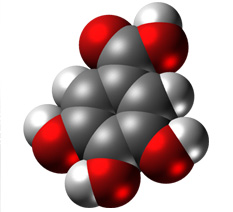







Gallic acid molecule
Gallic acid (3,4,5-trihydroxybenzoate) is a trihydroxybenzoic acid, a type of phenolic acid, a type of organic acid, also known as 3,4,5-trihydroxybenzoic acid, found in gallnuts, sumac, witch hazel, tea leaves, oak bark, and other plants.
Gallic acid has been isolated and identified as a tyrosinase inhibitor from many plants, and its inhibitory mechanism together with those of its ester derivatives has been well studied.
It has been found that gallic acid inhibited diphenolase activity of mushroom tyrosinase with a IC50 value of 4500 μM, which is 100-fold lower than that of kojic acid. In addition, gallic acid itself and its short alkyl chain esters (<C10) were oxidized by mushroom tyrosinase as substrates, but the long-chain alkyl chain esters (>C10) inhibited the enzyme without being oxidized. Gallic acid was also found to be very toxic to melanoma cells with cytotoxicity comparable to that of hydroquinone. Recently, Nithitanakool et al. isolated both gallic acid and its methyl derivative from seed kernels of Mangifera indica, and determined that both compounds were poor inhibitors against diphenolase activity of mushroom tyrosinase with 300- and 30-fold, respectively, lower activity than that of kojic acid. These results were consistent with previous studies.
In spite of the poor inhibitory activity of gallic acid itself, some compounds with gallate moiety were found to inhibit mushroom tyrosinase more effectively. Various gallic acid derivatives of hydroxyflavanols had been isolated from green tea and Galla rhois, and some of them were identified as strong tyrosinase inhibitors(63-65).
Gallic acid and its short alkyl (<C10) chain esters were oxidized by tyrosinase as substrates, yielding yellow oxidation products, but the long alkyl (>C10) chain esters inhibited the enzyme without producing the pigmented products, indicating that the carbon chain length was related to their tyrosinase inhibitory activity(64,66-68). The most abundant hydroxyflavanols in green tea included ECG [(-)epicatechin-3-O-gallate], GCG [(-)gallocatechin-3-O-gallate], EGCG [(-)epigallocatechin-3-O-gallate], and EGC [(-)epigallocatechin]. It was reported that EGCG and hinokitiol (structurally not related to hydroxyflavanols) were not only tyrosinase inhibitors, but also agents that decreased MITF production in cells. Similarly, three tyrosyl gallates were synthesized and showed stronger inhibitory activity.
In recent times, 1,2,3,4,6-pentagalloylglucopyranose isolated from the seed kernels of M. indica and the roots of Paeonia suffruticosa, respectively, was found to be 16-fold more active than gallic acid and inhibited monophenolase activity of mushroom tyrosinase with a non-competitive mode.
>
>
>
>
>
>
>
>
>
>
>
>
>
>
>
>
>
>
TYROSINASE INHIBITORS
Polyphenols
Benzaldehyde and Benzoate Derivatives
Gallic Acid and Derivatives
Long-Chain Lipids and Steroids
INHIBITORS OF MELANOSOMAL TRANSFER
Centaureidin and Methylophiopogonanone B
Niacinamide
PAR-2 Inhibitors
Lectins and Neoglycoproteins
ANTIOXIDANTS
Glutathione
Vitamin C
Alpha Tocopherol and Alpha Tocopherol Ferulate
ACCELERATORS OF EPIDERMAL TURNOVER AND DESQUAMATORS
α-Hydroxyacids
Salicylic Acid
Linoleic Acid
Retinoids
TRANSCRIPTIONAL REGULATION OF MELANOGENIC ENZYMES
The MAPK Pathway
MC1R
cAMP Pathway and MITF

<< Previous: Benzaldehyde and Benzoate Derivatives
Next: Long_Chain Lipids and Steroids >>